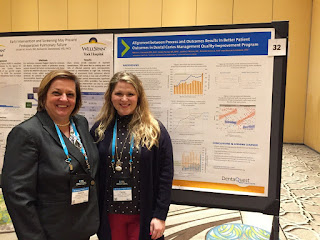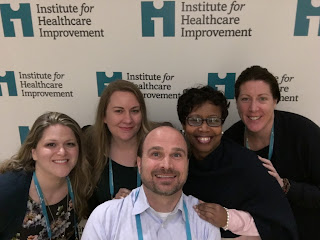As October comes to an end, so does the national observance r
ecognizing the need and importance of dental hygiene. For this Q&A, one of our own registered dental hygienists (RDHs) opens up about how she came to this career path and why it is invaluable to the oral health care system.
Let's dig in with Laura Skaret, RDH, BSDH | Project Manager, Safety Net Solutions | DentaQuest Institute
Q: Why did
you decide to become an RDH?
A: My mom is a dental hygienist, and I got my first job at her
office as a dental receptionist and then later was trained on the job to work
as a dental assistant. I loved my experience as an assistant and found the work
we did fascinating – including the devastating results of dental disease. I saw
the cycle of dental disease first hand:
teeth would need small restorations, then larger restorations, then root
canals, then crowns, and even sometimes implants. I knew I wanted to focus my
career on helping patients prevent and properly manage dental disease rather
than repairing the damage after it occurs.
We had a pamphlet in the office that
said that enamel was far more valuable than gold (referring to a gold
crown). I found that to be such a
thought-provoking and accurate concept.
It’s also similar to the old familiar adage, “an ounce of prevention is
worth a pound of cure.” That couldn’t be
more true in the dental field.
Q: Why are
hygienists important in the care team?
A: Dental hygienists are patient advocates. When explaining the dental disease process to
patients, I always tell them that my job is essentially to keep them out of the
dentist’s chair, but I can only do so much without their buy-in. Due to the nature of plaque biofilm, the
daily care that patients do for their own mouths is far more important than the
work that we do in one hour with them at the dental office. Patients go to the dental office maybe two to
four times per year, however 365 days a year they are responsible for managing
their own oral health. This means our
most important role is to educate and motivate our patients to improve their
daily oral health habits.
Q: What has
been your greatest accomplishment or most proud moment in relation to working
as an RDH?
A: I’ve realized that it’s not only what you do, but the way
that you do it that can make an impact.
I always try to be very kind and compassionate to the questions and
concerns of my patients. I’ve had several patients who were terrified of coming
to the dental office when I first met them. Years of neglecting their mouths
and avoiding the dentist would bring them to our office in a lot of pain and in
need of quite a bit of dental work. In addition to using a gentle technique and
local and topical anesthetics, I try to help them feel more comfortable by
talking them through everything I’m doing or telling them stories to get their
mind off of the situation. Sometimes
it’s helpful to listen to their story to find out why they have a fear, affirm
their past concern, and then assure them that won’t happen today.
When those patients then continue to come in
regularly, you know you’ve not only made a difference for their oral cavity,
but for their life as well. I had one
patient who needed lengthy measures to address advanced decay and periodontal
(gum) disease. After we completed her
first three visits of needed periodontal therapy, she actually sent a card to
my office to thank me for helping her overcome her fear of the dentist. With a more manageable level of fear, she was
able to get the care she needed to restore her smile, which gave her back her
confidence.
Q: How does
your professional background impact/influence/help you in your DentaQuest Institute (DQI) role?
A: My primary role at DQI is as a project manager for
Safety
Net Solutions (SNS), a DentaQuest Institute program. Safety Net Solutions
helps safety net dental clinics adopt targeted business management best
practices. Our focus is to ensure that
these dental offices can maintain financial viability to stay open and provide
access to care for the underserved. We
also help ensure that they understand their capacity and can maximize access to
care by optimizing their productivity.
My previous experience of working in all areas of the dental office
(receptionist, chairside with the dentist, and then also as a hygienist) means
I have very comprehensive knowledge of how dental offices work, from scheduling
appointments, to managing supplies and inventory, to managing the patient’s care
experience, to dealing with dental equipment and instrument shortages.
Basically, I can understand and relate to almost any concerns our SNS clients
have.
Q: Why do
you continue private practice once a week?
A: Although you can technically keep your annual dental hygiene
license “active” by simply paying the license fee each year, I want to keep it
active with actual patient care, as well. Also I continue to practice because I love the work! I love working with patients and helping them
improve their oral health. I also believe this helps me stay relevant and
engaged with my SNS clients and their common concerns.
Q: What is
one message you hope to impart to anyone interested in becoming an RDH?
A: Hygienists are super important members of the care
team! As policy changes and we move
forward with accountable care organizations and pay for performance insurance
reimbursement models, I think the role dental hygienists play in preventing and
managing disease will be brought even more into the forefront. When finances are attached to healthy patient
outcomes, dental care teams will attach an even higher value to dental
hygienists.
Also, there is a massive shortage of dental professionals – and dentists
in particular – nationwide. Maximizing the use of preventive modalities such as
sealants, fluoride varnish, and silver diamine fluoride will help address
access gaps where dentists are hard to come by, like rural areas. Of course, we will never stop needing the
education and skills of a dentist, but if we can reduce the demand for the
skills of a dentist by reducing the dental disease burden, we can help minimize
the gap in access to oral health care.






